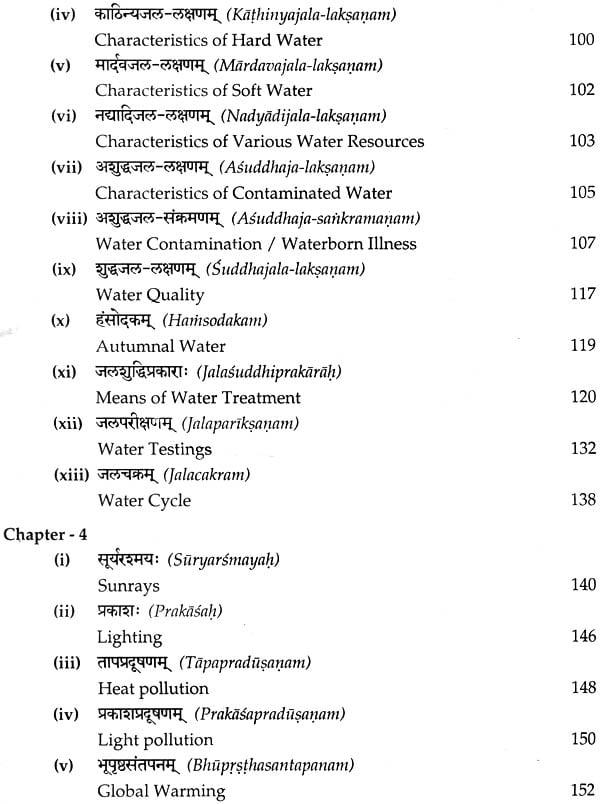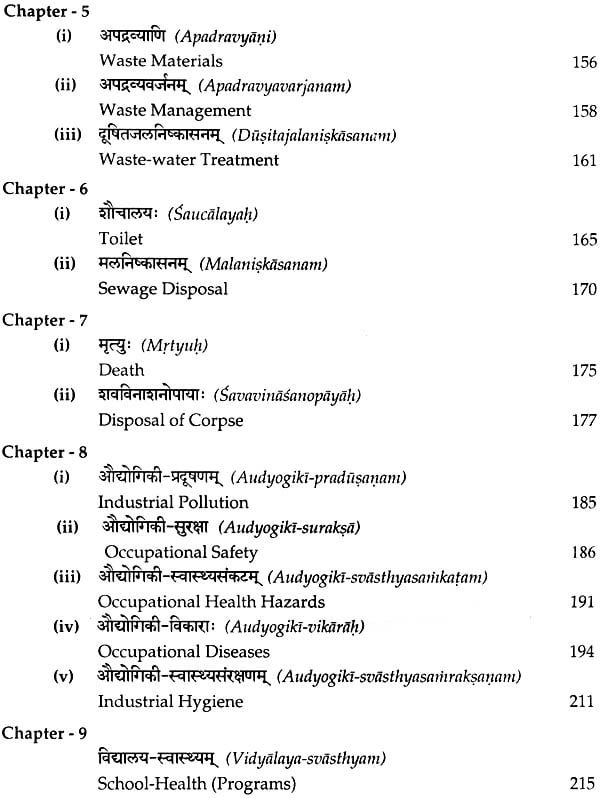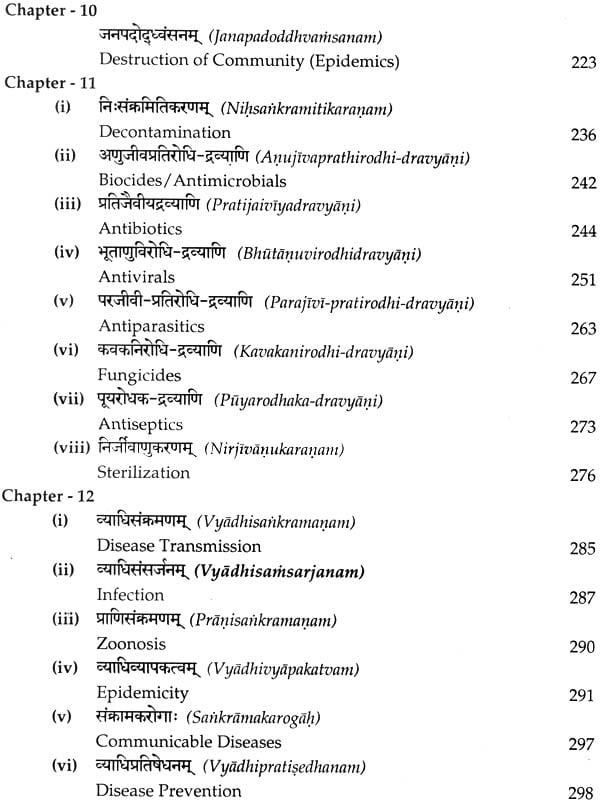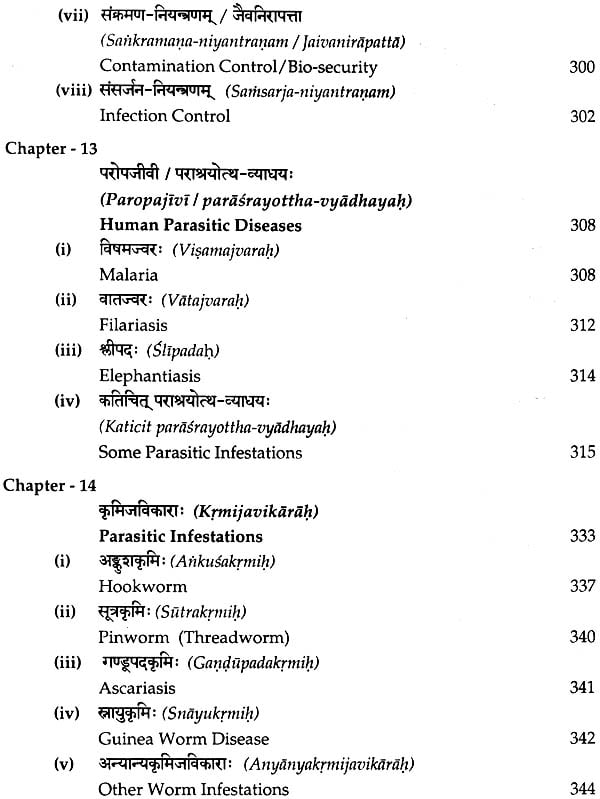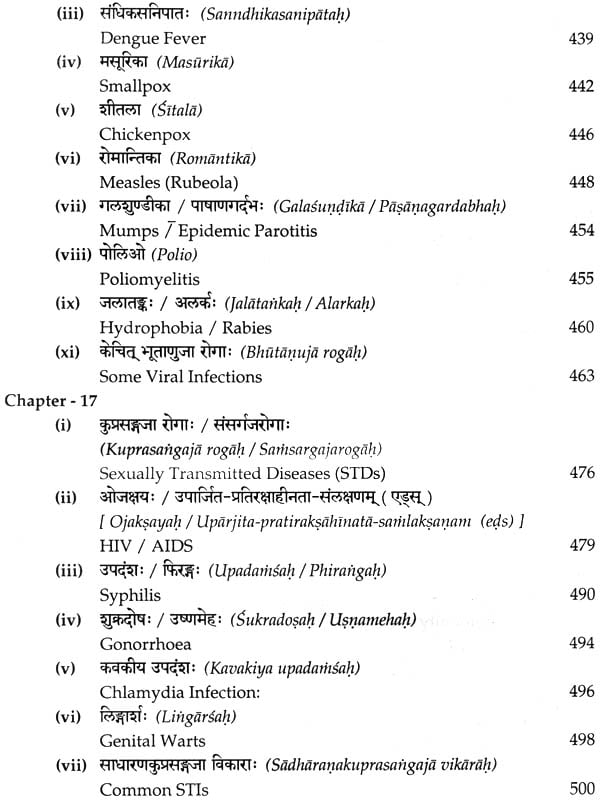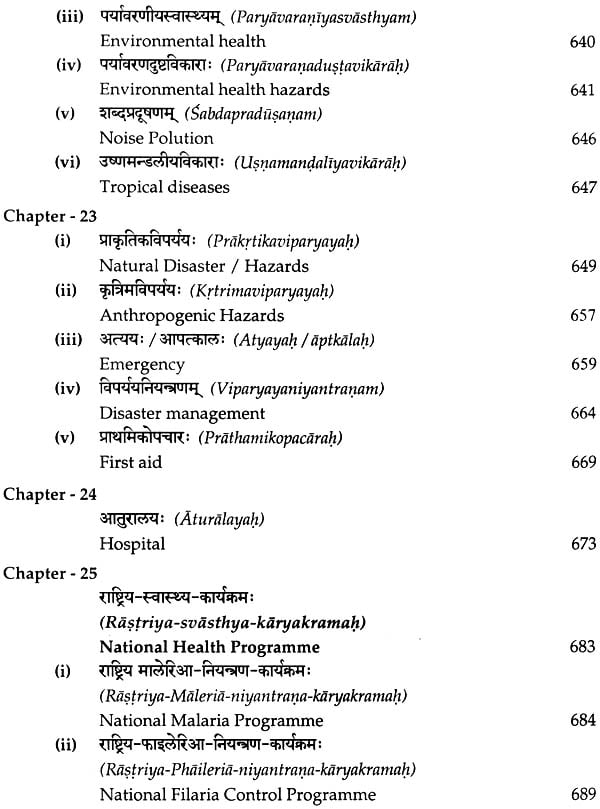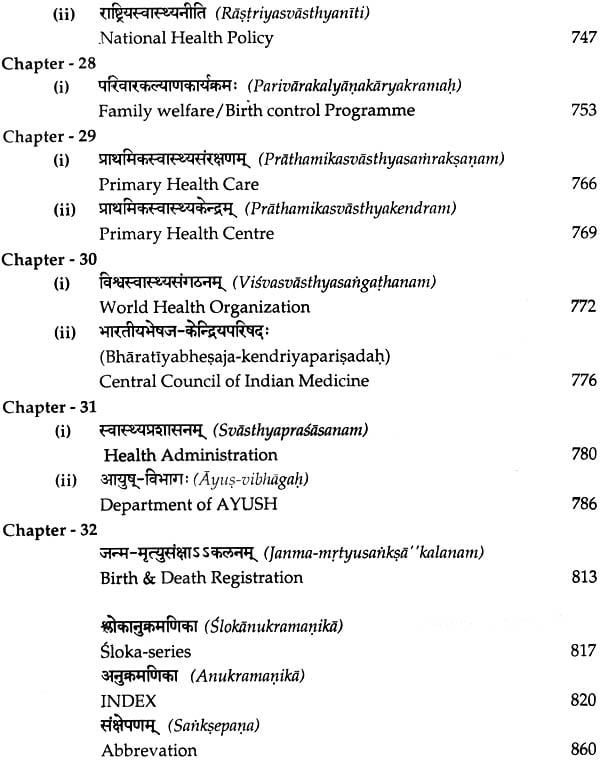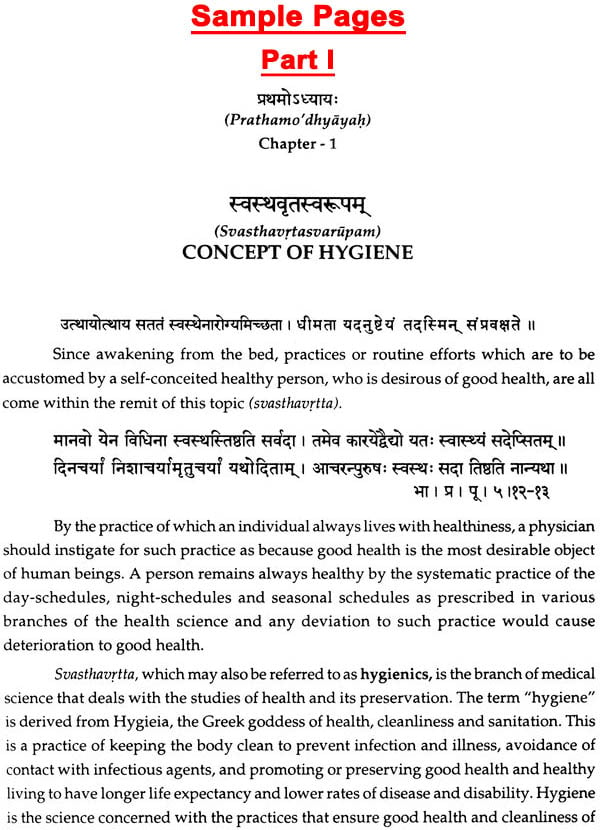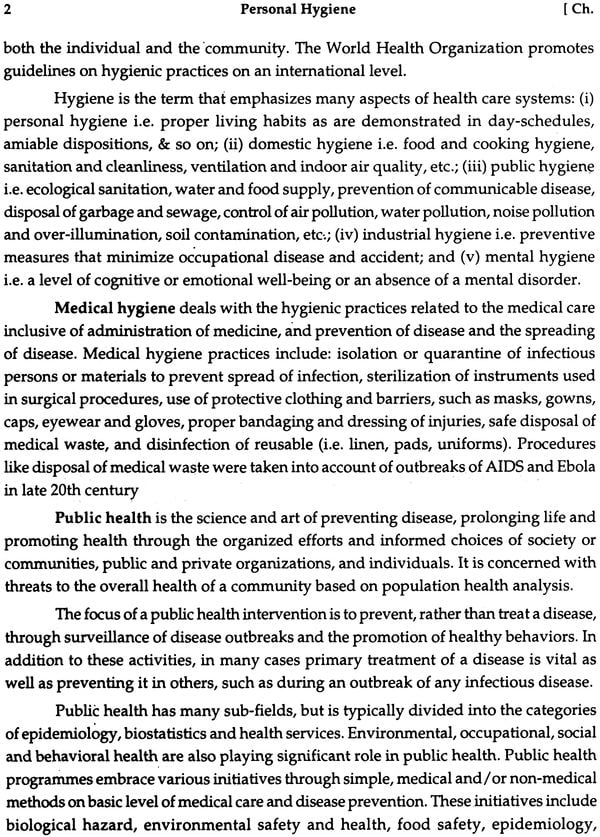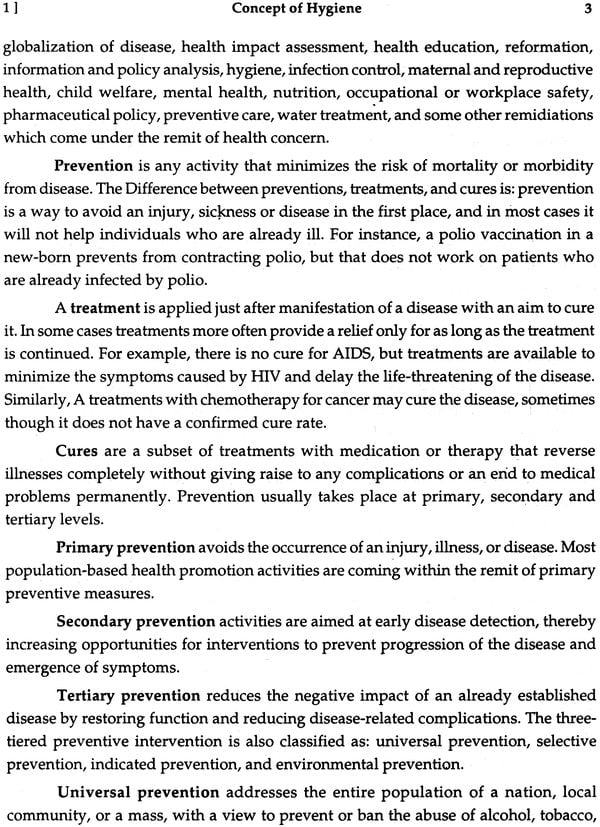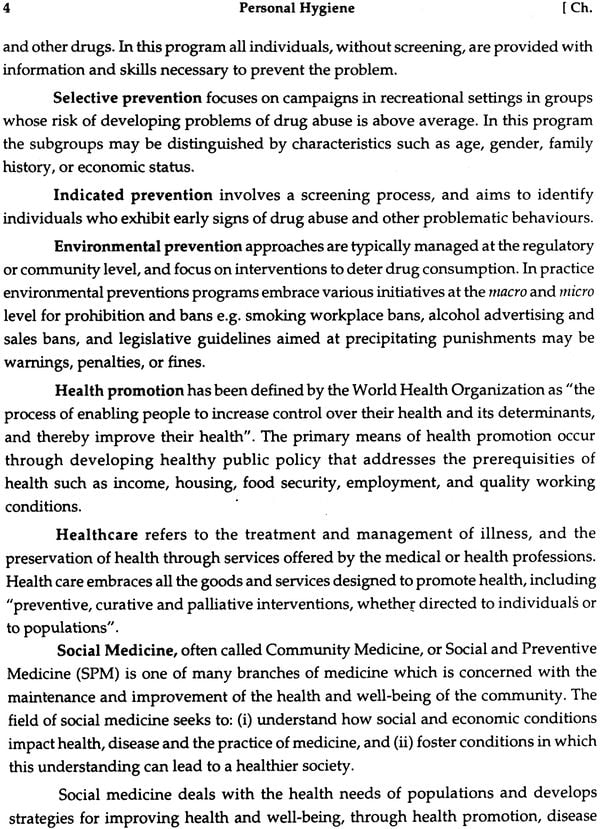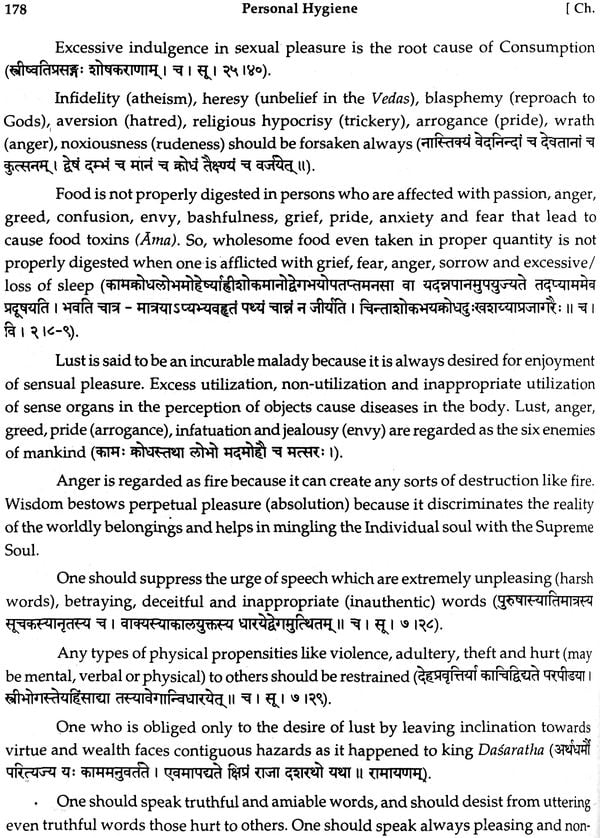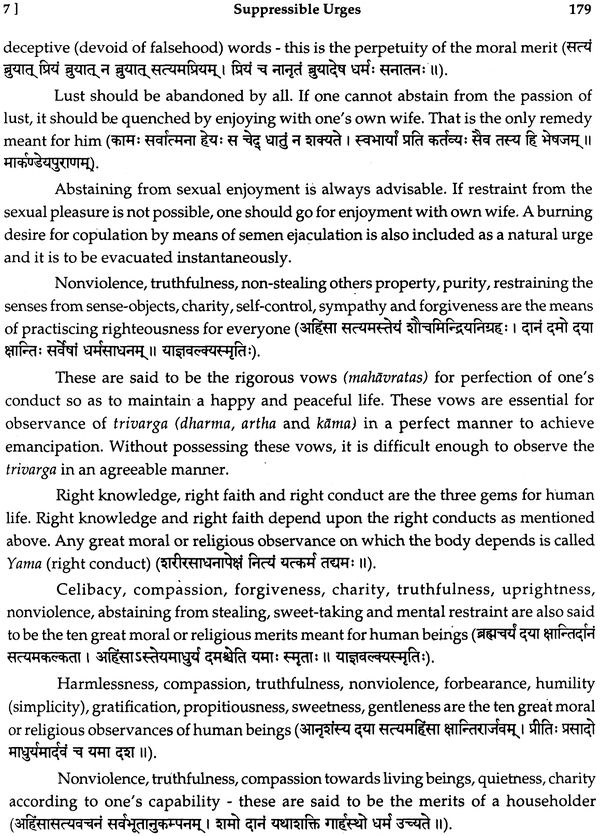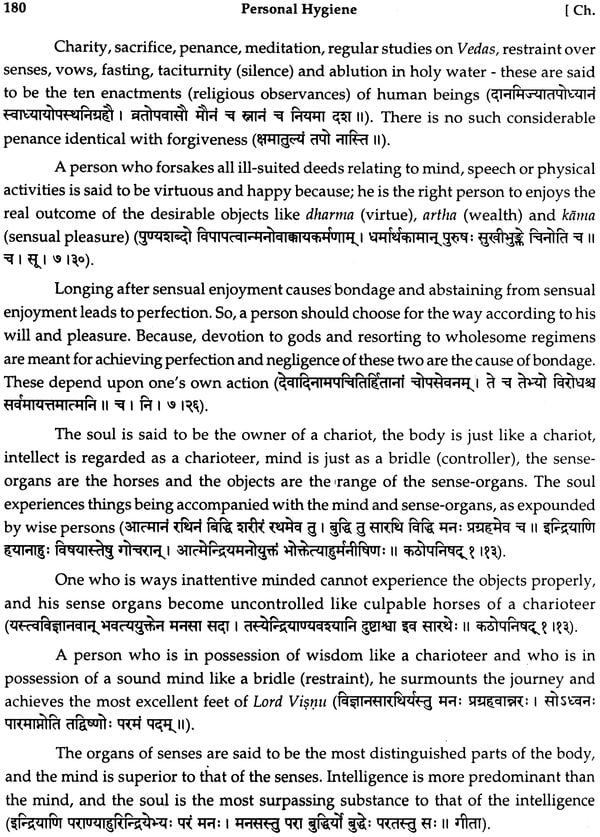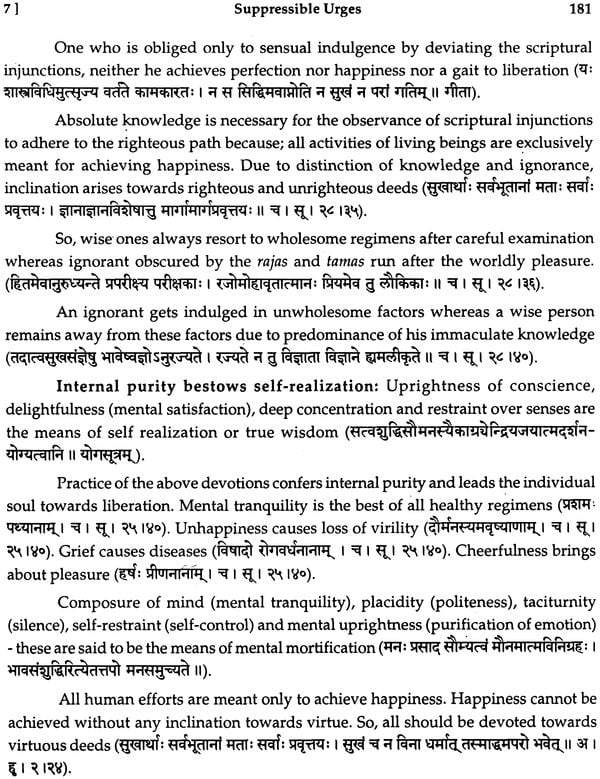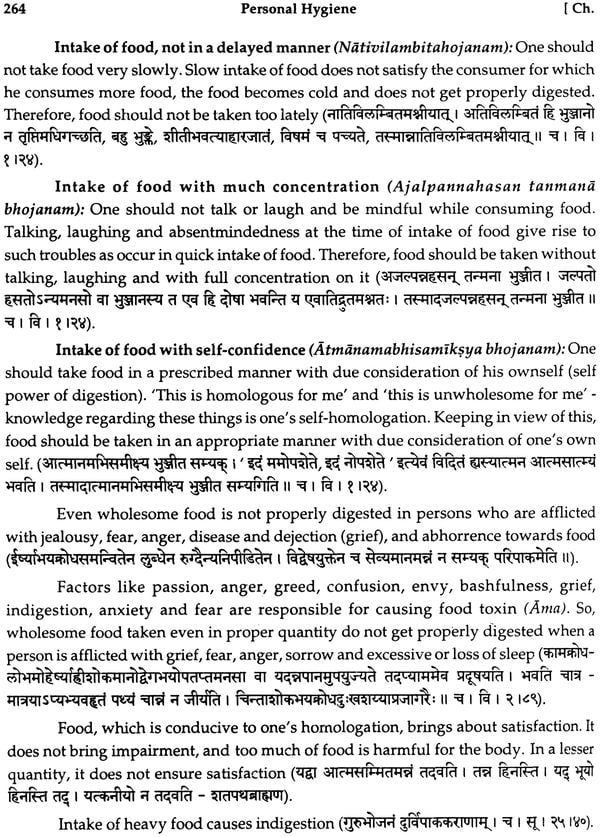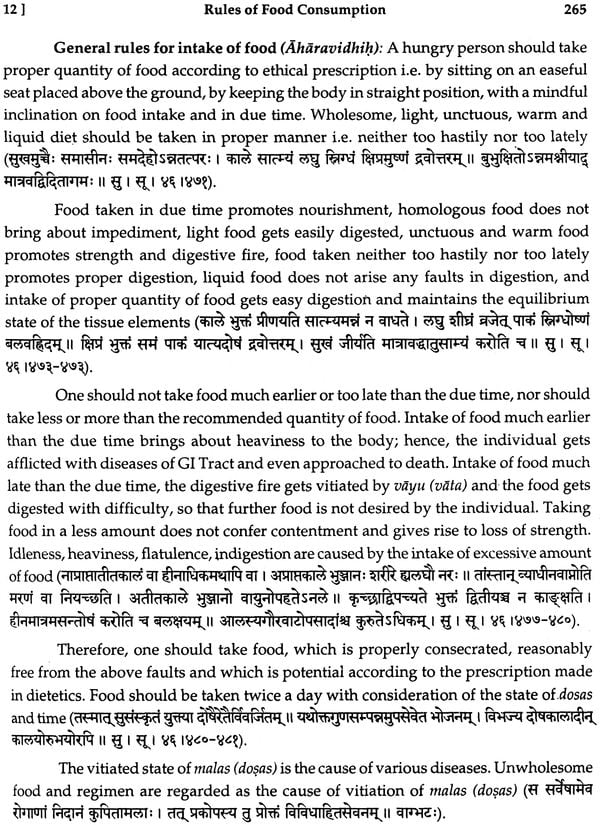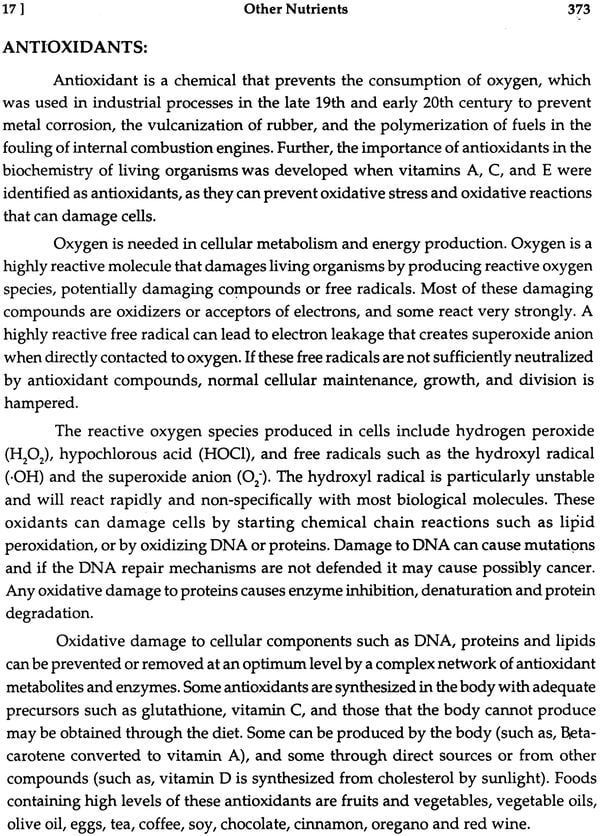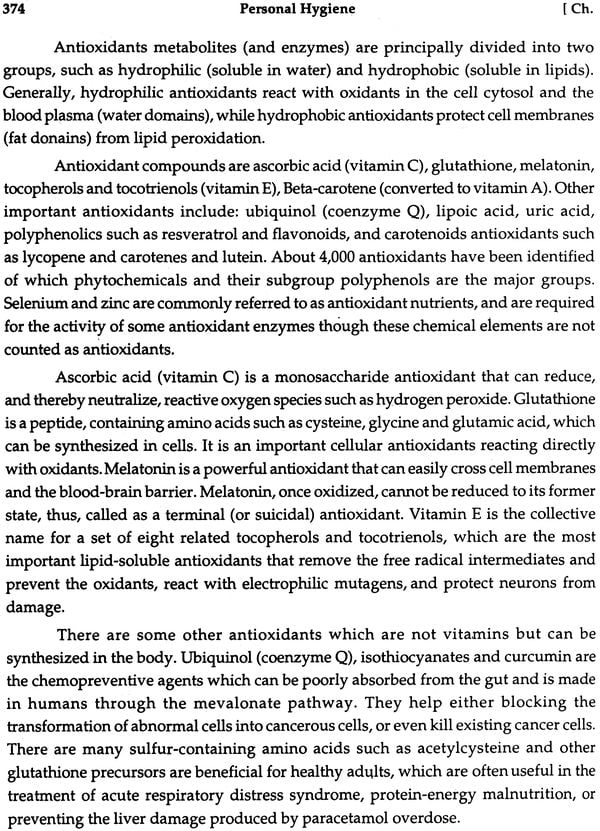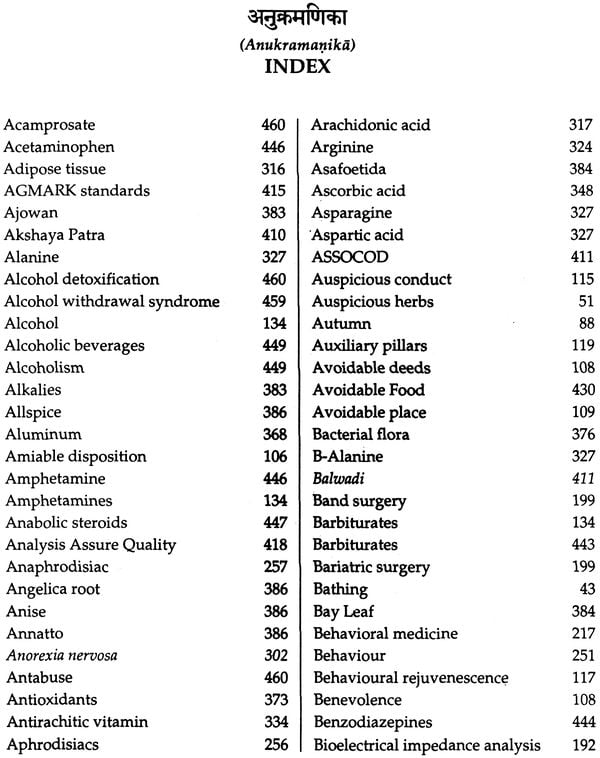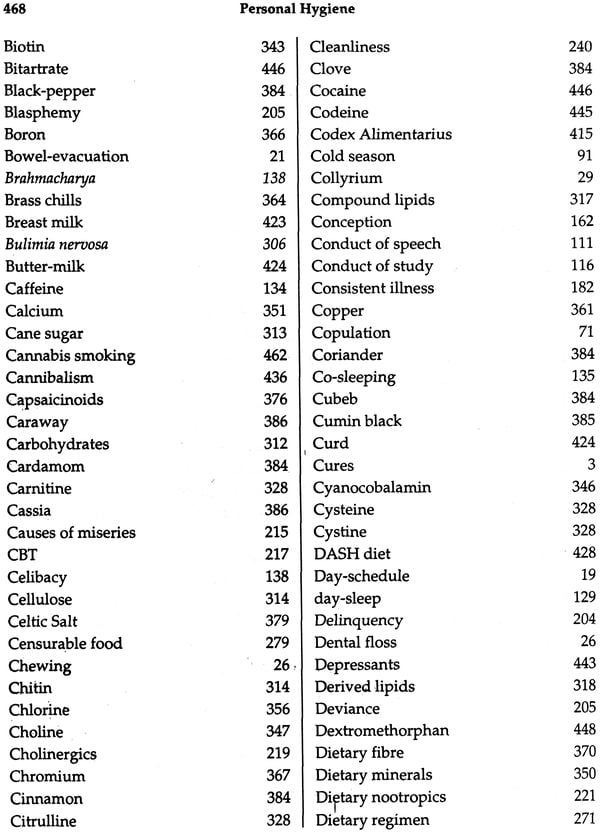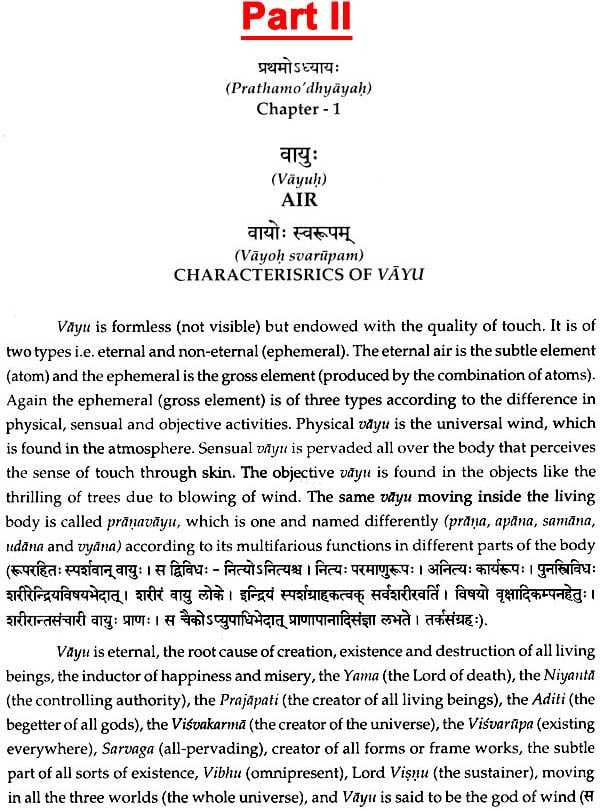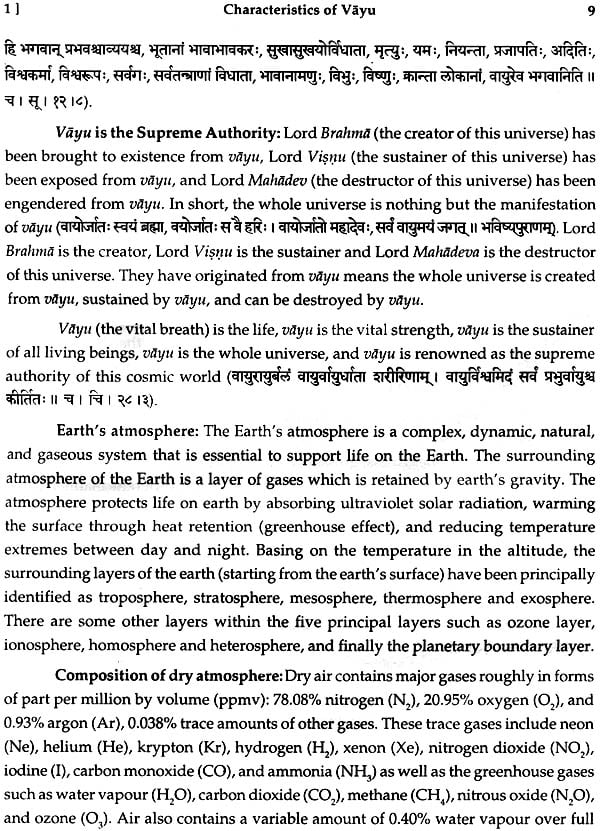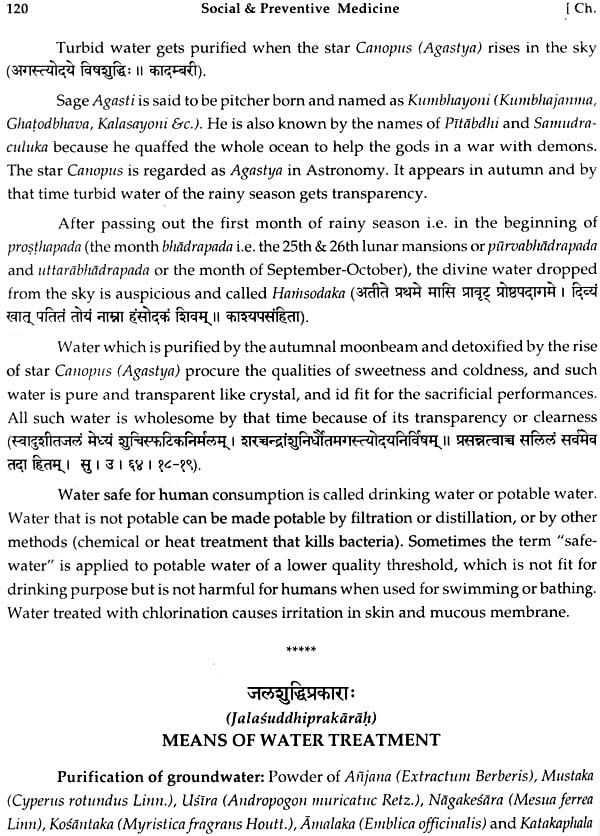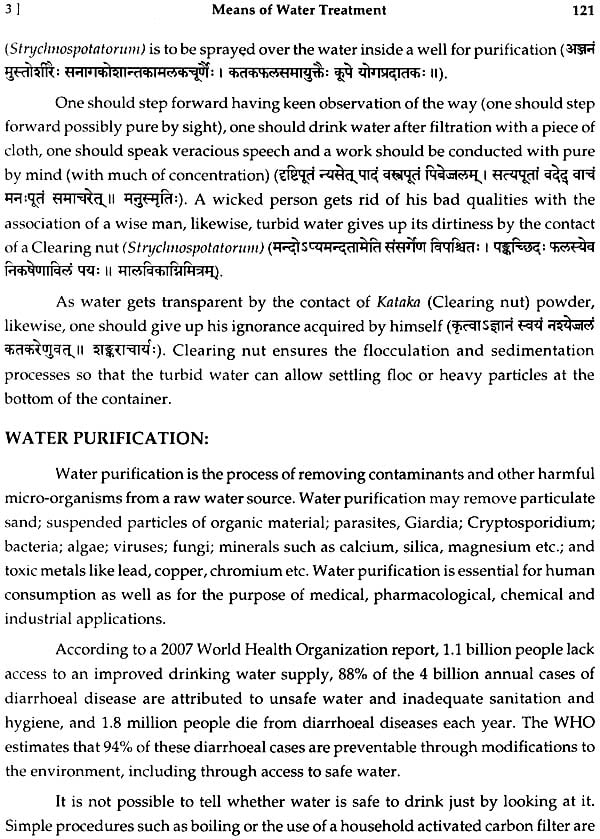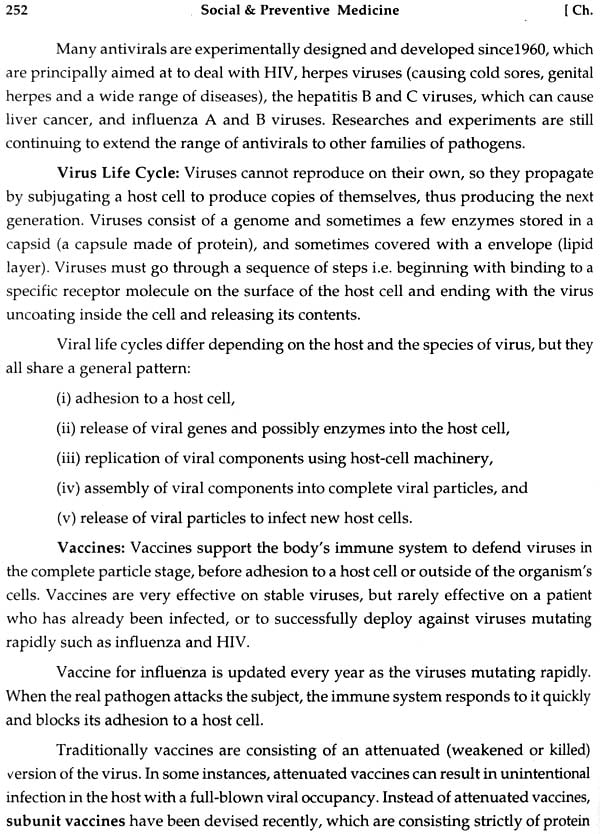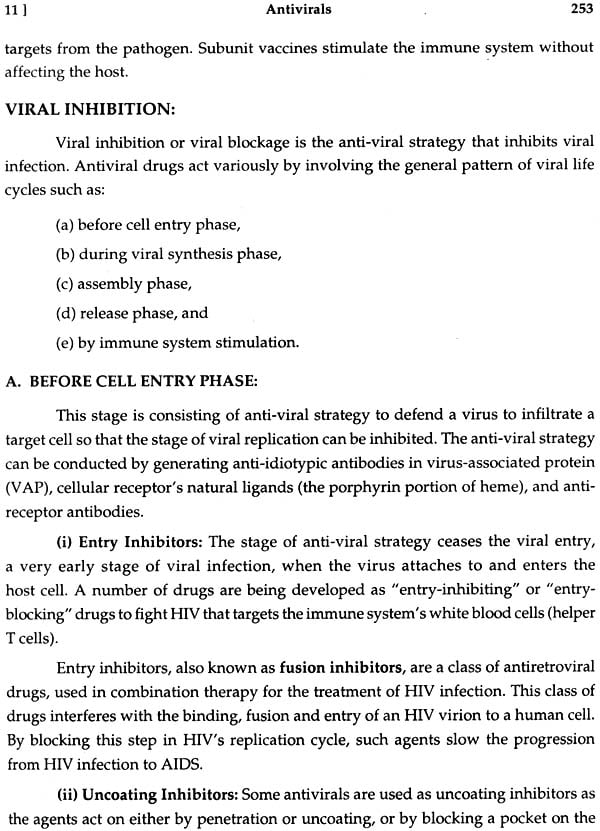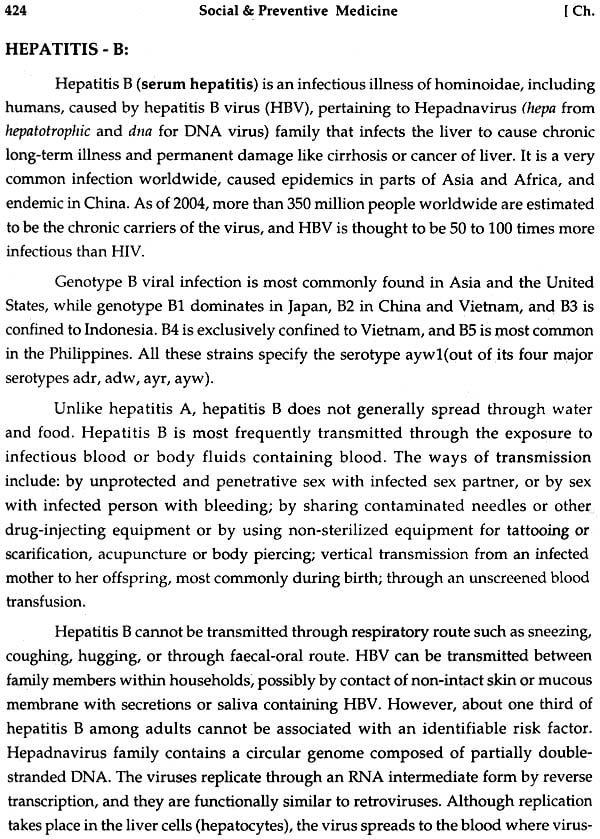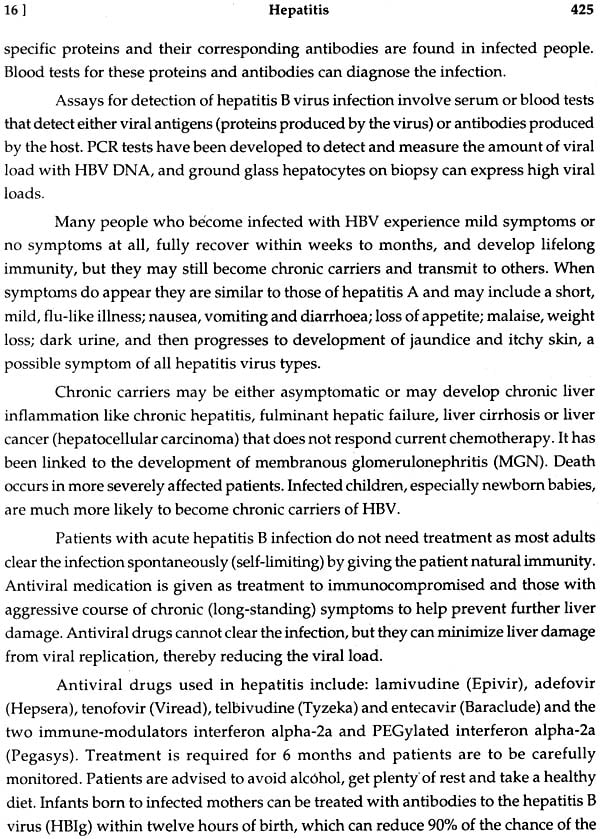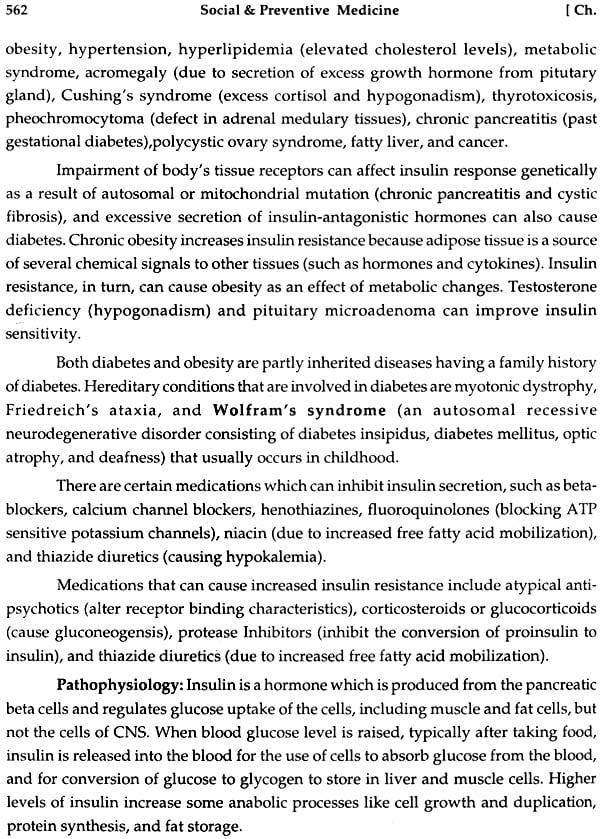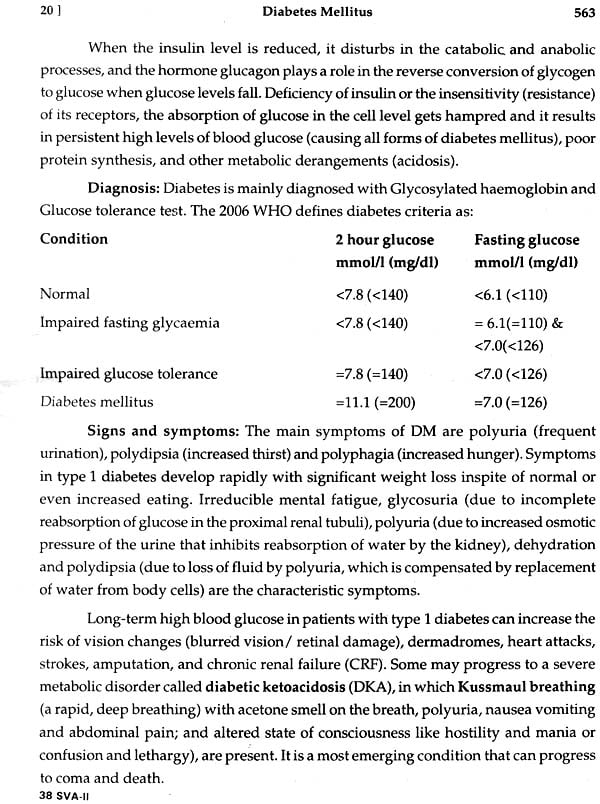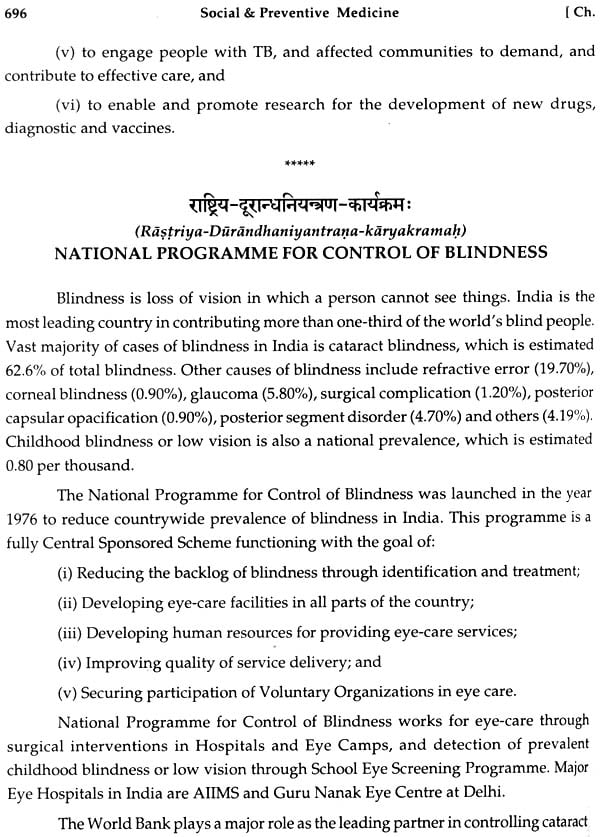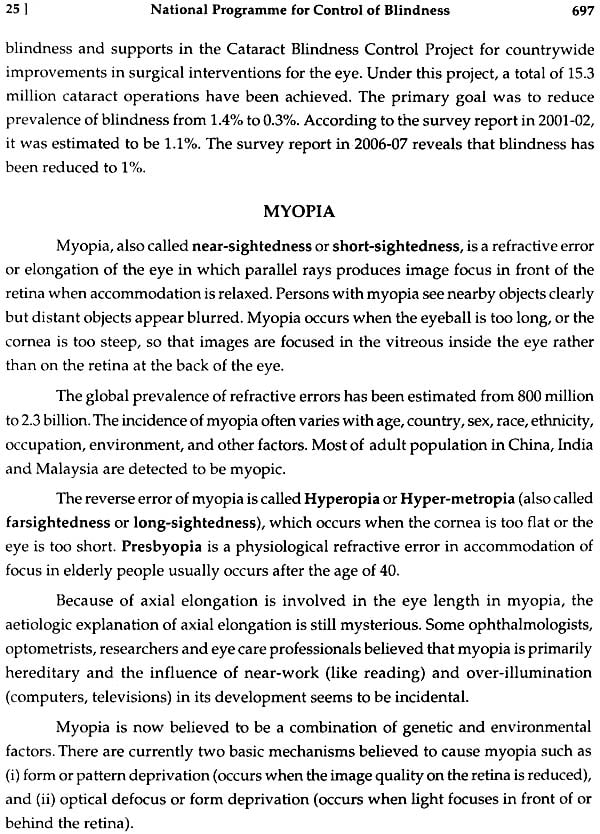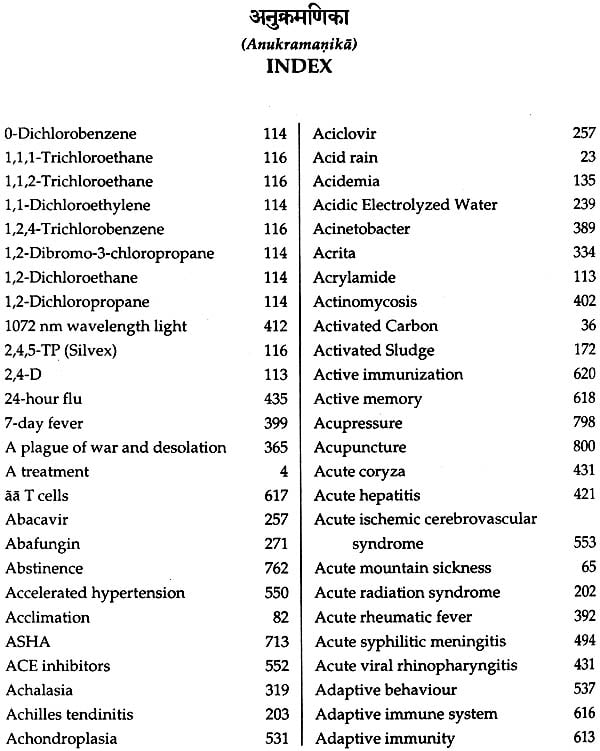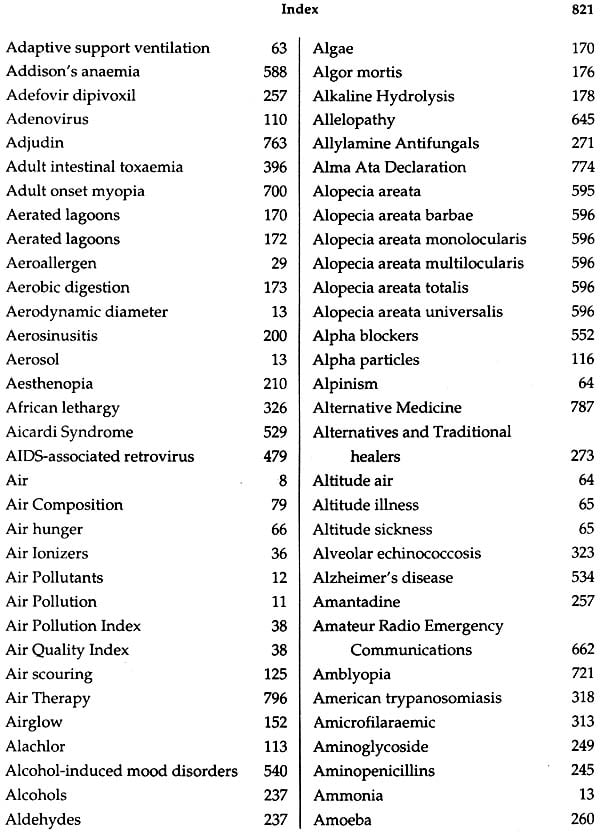
Svasthavrttam: Text and English Version with Modern Views (Set of 2 Volumes)
Book Specification
| Item Code: | NAN281 |
| Author: | Dr. Ghanashyam Dora |
| Publisher: | Chowkhamba Sanskrit Series Office |
| Language: | English |
| Edition: | 2010 |
| ISBN: | 9788170803508 |
| Pages: | 1436 |
| Cover: | Paperback |
| Other Details | 9.5 inch X 7.5 inch |
| Weight | 2.10 kg |
Book Description
The text ‘Svasthavritta’ compiled by Dr. Ghanashyam Dora is a comparative expression of the basic therapeutic approach of ancient Indian System of Medicines and modern facts and trends meant for maintenance and promotion of good health, prevention of diseases and cure of illness. This edition covers the entire syllabus at UG and PG levels, as prescribed by CCIM, and is substantiated with health-provoking elements, which will be of enormous necessity and constant source of impetus to the student of Ayurvedic discipline.
Prevention is any activity which reduces the risk of morality or morbidity from disease, and initiates to abate the transmission of diseases and deaths caused by food incompatibilities, pollution, aging, injury, drug abuse and environmental or ecological factors. This edition deals with vast and varied specialities of medicine that encompasses physical, psychological, emotional, and social well being so as to have longer life expectancy and lower rates of disability.
Despite these, this branch of Medicine addresses all human-health-related aspects of both the natural environment and the built environment, and provides the ways of combating the onset and threats of potentially detrimental/infectious diseases and epidemics, may be endemic, pandemic or syndemic nature, which are extensively prevalent among a group of human population of a region, caste, creed and may other boundaries. Preventive & Social Medicine also deals the ongoing policies and programmes envisaged by WHO and other health- related National and International Organizations that come within the remit of health and safety. Everywhere of this edition, the readers will be pleased to experience the healthcare measures revealed extensively in the spheres of Ayurveda, India Philosophical Schools, ethics and spiritualism, and modern medical viewpoints as well.
Ayurveda being a holistic science of life rather medicine, has its foremost importance and aim how to maintain the health of the healthy person and also provides the preventive, promotive and curative aspects of positive and complete health. It is also a well-known fact that it is the Ayurvedic science which defines the complete definition of health, and which is now accepted by the World Health Organization. The description about the psychosomatic concept of life is also the unique concept of this science, which has been mentioned long long ago, when other medical sciences were not awaring about.
Hence it is very clear that Ayurveda has a big treasure of knowledge; not only to cure the diseases but also have a unique, specific and elaborative knowledge in the field of health sciences and it is termed as Svasthavrittam. The word Svasthavrittam itself recommend its meaningful meaning that the routine and behaviour of the person which keeps the men healthy as well as such routine which is to be followed by the healthy person to keep and maintain healthy state “svasmin tisthati yah sa svasthah”. It indicates the particular state of the purusha in which all the components of purusha viz. body, and its contents like dosa, dhatu and malas along with upadhatus too, are in such pramana, means in equilibrium state that performing their normal functions.
Since the subject of Svasthavritta has elaborately described in Samhitas and other classics of Ayurveda, but it even requires its clarification in such a way so that it may be easily assimilated by the society as well as the scholars. Hence there is absolutely need of such texts, especially as per the need of time in English language. Dr Ghanashyam Dora has tried and made great efforts to provide such a text to fill the need of the time in form of a textbook to the students. I read the book thoroughly and found it is much suitable and able to communicate the textual knowledge, in easy and palatable form to get and understand the subject on scientific way and applicable ground.
I congratulate Dr. Dora for his efforts and hope that his valuable efforts would certainly be accepted by the society, and wish all the success in his academic carrier.
Foreword
The text ‘Svasthavrittam’ compiled by Dr. Ghanashyam Dora is an anthology of soothsayings in consonance with various health related issues of paramount Importance. Each and every topic of this text is endowed with the fundamentals of Ayurvedic doctrines, codes of conduct, sustenance of individual and social life as well as philosophical and spiritual practices implicated with the Ayurvedic standpoint. This text is also a culmination of meticulously identified thoughts, physical and metaphysical vision of life lying scattered in the splendidly enriched storehouse of Ayurvedic Science. The text, therefore, explicitly aims at inviting the interest of the individuals towards sustenance of good health as well as prevention of disease and disability which is certainly an unparalleled contribution of India to the global people disseminating the massage of amity, world peace, sound health and mind perpetually. the approach of this text is evidently getting more and more importance inn the perspective of multifarious contra-indications and side-effects of modern medicine Eventually, the mankind, as a whole, is seeking shelter in the safe, peaceful and echo-friendly custody of the Ayurveda for obvious reasons.
In view of changing world scenario of the present time, the Ayurvedic system of medicine and treatment is regaining its pristine status as well as inviolable state of application to the people of the globe irrespective of caste, creed and religion. Taking all these facts and trends into account, Dr. Dora, an eminent physician, teacher cum- Sanskritist has sincerely endeavoured to expatiate these hygienic soothsayings in this present edition for the benefit of mankind in the form of lucidification with excellent exposition and excogitation of the said text in a vivacious and commendable manner. Everywhere of this edition, the readers will be pleased to experience the profoundness of knowledge of Dr. Dora revealed extensively in the spheres of Ayurveda, Sanskrit literature both Vedic and classical, viewpoints of Indian Philosophical Schools, ethics and spiritualism as well. The present edition is substantiated with thought-provoking elements, which, I believe, will be of enormous necessity and constant source of impetus to the students of Ayurvedic discipline.
Dr. Ghanahyam Dora has also been successful in appeasing the aspirations of the general readers with the capacity of his stunning style of delineation blended with classical taste. I am of firm belief that by dint of his preserved edition, Dr. Dora will be aptly appreciated by the intelligentia and recognized by and by as one of the exponents who worked hard for ameliorating and popularizing the Ayurveda for veritable service of the mankind.
CONTENTS
| Chapter - 1 | ||
| (i) | (Svasthavrttasvarupam) Concept of Hygiene | 1 |
| (ii) | (Svasthavrttaprayojanam) Objectives of Hygiene | 5 |
| (iii) | (Svasthalaksanam) Characteristics of Good Health | 9 |
| (iv) | (Svasthyalaksanam) Characteristics of Healthy Individuals | 14 |
| Chapter - 2 | ||
| (Dinacarya prakaranam) Day Schedules | 19 | |
| (i) | (Pratahsayyatyagah) Early Waking | 19 |
| (ii) | (Malamutrotsargah) Evacuation of Bowels | 21 |
| (iii) | (Mukhasodhanam) Oral Hygiene | 23 |
| (iv) | (Nsyavidhih) Nasal Therapy | 27 |
| (v) | (Anjanam) Collyrium | 29 |
| (vi) | (Dhumapanam) Medicated Smoking | 30 |
| (vii) | (Sarirasauca) Physical Cleanliness | 32 |
| (viii) | (Vyayamah) Exercise | 33 |
| (ix) | (Abhyangah) Massage | 40 |
| (x) | (Snanam) Bathing | 43 |
| (xi) | (Prasadhanani) Toiletries | 48 |
| (xii) | (Bhojanam) Food Hygiene | 52 |
| (xiii) | (Bhojanottarasvasthyaraksa) Hygiene after taking food | 62 |
| (xiv) | (Usnisadi-dharanam) Use of Turban &c. | 66 |
| Chapter - 3 | ||
| (Ratricarya prakaranam) Night Schedules | 69 | |
| Chapter - 4 | ||
| (Ratricarya prakaranam) Seasonal Schedules | 81 | |
| (i) | (Varsa-rtucarya) Observances in Rainy Season | 84 |
| (ii) | (sarad-rtucarya) Observances in the Autumn | 88 |
| (iii) | (Hemanta-rtucarya) Observances in Cold Season | 91 |
| (iv) | (Sisira-rtucarya) Observances in the Winter | 94 |
| (v) | (Vasanta-rtucarya) Observances in the Spring | 95 |
| (vi) | (Grisma-rtucarya) Observances in Summer | 100 |
| (vii) | (Pravrt-rtucarya) Observances in Early Rains | 102 |
| (viii) | (Samanyartucarya) Seasonal Schedules in general | 104 |
| (ix) | (Rtusandhih) Seasonal Junction | 104 |
| (x) | (Yamadamstra) Seasonal Libation | 105 |
| Chapter - 5 | ||
| (i) | (Sadvrtam) Amiable Dispositions | 106 |
| (ii) | (Sadvrttamahattvam) Advantages of Amiable dispositions | 116 |
| (iii) | (Achararasayanam) Behavioural Rejuvenescence | 117 |
| Chapter - 6 | ||
| (i) | (Trayopasthambhah) Three Sub-posts | 119 |
| (ii) | (Aharah) Food | 121 |
| (iii) | (Nidra) Sleep | 125 |
| (iv) | (Svapnah) Dream | 137 |
| (v) | (Brahmacaryam) Celibacy | 138 |
| (vi) | (Abrahmacaryah) Householder’s Celibacy | 153 |
| Chapter - 7 | ||
| (i) | (Adharaniyavegah) Non-suppressible Urges | 166 |
| (ii) | (Dharaniyavegah) Suppressible Urges | 176 |
| (iii) | (Sada’’ turah purusah) Persons of Consistent Illness | 182 |
| Chapter - 8 | ||
| (i) | (Upavasah/Langhanam) Fasting (Lightening Therapy) | 183 |
| (ii) | (Ninditah purusah) Undesirable Persons | 190 |
| (iii) | (Atisthaulyam) Over-corpulence (Obesity) | 191 |
| (iv) | (Atikarsyam) Excessive Emaciation | 199 |
| (v) | (Aninditah purusah) Good Built Persons | 203 |
| Chapter - 9 | ||
| (i) | (Aparadham) Delinquency | 204 |
| (ii) | (Prajnaparadham) Intellectual Delinquency | 206 |
| (iii) | (Upadha) Sensual Desire | 222 |
| Chapter - 10 | ||
| (i) | (Sarirasamsodhanam) Purifying Measures of the Body | 231 |
| (ii) | (Saucah) Purity | 240 |
| Chapter - 11 | ||
| (i) | (Sarirasamhraksanam) Protective Measures of the Body | 246 |
| (ii) | (Sariraraksa-sadhanani) Means of Natural Health | 249 |
| (iii) | (Jivitakanksa) Life Expectancy | 254 |
| Chapter - 12 | ||
| (i) | (Aharavidhih) Rules of Food Consumption | 258 |
| (ii) | (Astavaharavidhivisesayatanani) Eight Factors Determining the Utility of Food | 266 |
| (iii) | (Pathyapathyaharah) Dietary Regimen | 271 |
| (iv) | (Pathyaharah) Wholesome Food | 275 |
| (v) | (Apathyaharah) Insalubrious Food | 278 |
| Chapter - 13 | ||
| (i) | (Ahara-parcanakalah) Duration of Digestion | 281 |
| (ii) | (Ahara-dusparinamaja-rogah) Diseases caused by Indigestion | 283 |
| (iii) | (Aharaja-vikarah) Food-born Illnesses | 287 |
| (iv) | (Santarpanaja-rogah) Diseases caused by Heperalimentation | 295 |
| (v) | (Apatarpanaja-rogah) Diseases caused by Malnourishment | 297 |
| (vi) | (Bhaksavikarah) Eating Disorders | 300 |
| Chapter - 14 | ||
| (i) | (Ahara-pramana-posanam) Nutritional Value of Food | 310 |
| (ii) | (Aharadravyani) Nutrients | 311 |
| (iii) | (Svetasaraharah) Carbohydrates | 312 |
| (iv) | (Snehasaraharah) Fats | 316 |
| (v) | (Paustikaharah) Proteins | 320 |
| Amino Acids | 322 | |
| Chapter - 15 | ||
| (Jivatiktakah) | 331 | |
| (a) Fat soluble Vitamins | 332 | |
| (b) Water soluble Vitamins | 338 | |
| Chapter - 16 | ||
| (Aharopayogi-dhatavah) Dietary Minerals | 350 | |
| (a) Major Minerals | 351 | |
| (b) Minor or Trace Minerals | 359 | |
| Chapter - 17 | ||
| (i) | (Anyanyaharadravyani) Other Nutrients | 370 |
| (a) Dietary fibre | 370 | |
| (b) Antioxidants | 373 | |
| (c) Phytochemicals | 375 | |
| (d) Bacterial flora | 376 | |
| (ii) | (Lavanani) Salts | 376 |
| (iii) | (Aharayogi-dravyani) Food adjuvants | 382 |
| Chapter - 18 | ||
| (i) | (Adarsaharah) Healthy diet | 388 |
| (ii) | (Sadrasabhojanasya mahattvam) Importance of Six Tastes in Food | 391 |
| (iii) | (Avasthanusaramaharam) Nutrition in various stages of Life | 393 |
| (iv) | (Desanurupam posana-manapariksa) Social Aspect of Nutrition | 400 |
| (v) | (Samajika-posana-parinamah) Social Problems of Nutrition | 402 |
| (vi) | (Rastriyaposanakaryakramah) National Programs on Nutrition | 403 |
| Chapter - 19 | ||
| (i) | (Aharapariksanam) Nutrional Rating & Food Standards | 413 |
| (ii) | (Mamsapariksanam) Meat Hygiene | 416 |
| (iii) | (Dugdhapariksanam) Milk Analysis | 419 |
| (iv) | (Sakaharah) Vegetarian Food | 425 |
| (v) | (Mamsaharah) Non-vegetarian Food | 429 |
| (vi) | (Mamsaharah) Non-vegetarian Food | 429 |
| (vii) | (Aharamatra) Quantity of Food | 437 |
| Chapter - 20 | ||
| (i) | (Madakadravyanam prabhavah) Effects of Narcotics | 441 |
| (ii) | (Madakadravyapayogah) Drug Abuse/Addiction | 442 |
| (iii) | (Madyapanam) Alcoholism | 450 |
| (iv) | (Dhumapanam) Smoking | 461 |
| (Anukramanika) Index | 467 | |
| (Slokanukramanika) sloka-series | 475 | |
| (subhasitani) Soothsayings | 497 | |
| (Sanksepana) Abbrevation | 503 |
Part II
Life in Ayurveda is conceived as the aggregation of body, senses, mind and soul. The total body matrix in living man is a conglomeration of three humours (Vata, Pitta & Kapha), seven basic tissues (rasa, rakta, mamsa, medas, asthi, majja & sukra) and the waste products of the body such as purisa (faeces), mutra (urine) and sveda (sweat). These body humours, basic tissues, and waste products are based on the balanced condensation of five basic elements (pancamahabhatas) namely, earth (prthvi), water (jala), fire (agni), air (Vayu) and vacuum or ether (akasa). According to Ayurveda all objects in the universe including human body, and food that replenish or nourish, are composed of five basic elements. The growth and decay of this body matrix and its constituents revolve around food & regimen, and the means of food intake and its digestion, absorption, assimilation and metabolism that have interplay in health and disease.
Healthiness or illness depends on the presence or absence of equilibrium state of the total body matrix and its different constituents. Both the intrinsic and extrinsic factors including dietary indiscrimination, undesirable habits and non-observance of rules of healthy living can disrupt the natural state of the total body matrix and give rise to various ailments. There are some other factors such as seasonal abnormalities, rash behaviour, suppression of natural urges, erratic application of sense organs and incompatible actions of the body and mind can also result in creating disturbance of the existing normal balance. Health Promotion and Health Maintenance is achieved through restoring the balance of disturbed body-mind matrix, and through regulating diet, following life-routine and behaviour, administration of drugs and resorting to preventive pancakarma and rasayana therapy.
The basic therapeutic approach in Ayurveda is, 'that alone is the right treatment which restores good health and he alone is the real physician who relinquishes one from disease'. This sums up the maintenance and promotion of health, prevention of disease and cure of sickness. The principal objectives of Ayurveda are to conserve the good health of healthy individuals and to eliminate diseases from sick ones (svasthasya svasthyaraksanam, aturasya vikaraprasamanam ca). Ayurveda embraces several theories basing on health promotion and health maintenance of individuals and populations that are confirmed by ancient foreseers in terms of Svasthavrittam, which is universally appreciated and has an age long tradition behind it. These are mainly based on safe environment, enhanced immunity, sensible behaviour, good nutrition, well-born children, and prudent healthcare.
The present text 'Svasthavrittam' Part II concerning to Social and Preventive Medicine (SPM), compiled by Dr. Ghanashyam Dora is a culmination of various aspects of public healthcare measures in consonance with various health related issues of paramount importance. Dr. Dora has tried to reveal elaborately the ancient Indian thoughts of healthcare systems as has been prescribed in the syllabus at the Graduate and Post Graduate levels by the Central Council of Indian Medicines, New Delhi.
I had a very pleasant experience to go through the entire text that covers both the ancient and modern aspect of the syllabus which will be undoubtedly, helpful in appeasing the aspirations of students of this discipline. Dr. Dora is praiseworthy for bringing out such an edition of the text and I hope this will be highly appreciated by the readers.
The text "Svasthavrittam Part II" concerning to "Social and Preventive Medicine" (SPM) is an emphasis on the present trend of public health-care systems and hygienic practices beneficial in the day-to-day life of each individual. The text embraces both the medical services designed to promote health, including preventive, curative and palliative intervention, as well as other complementary and alternative systems of medicine including ethical health- related teachings. "Public health is the science and art of preventing disease, promoting health and prolonging life through the organized efforts and informed choices of society or communities and individuals". It is concerned with threats to the overall health of a community, rather than individual health issues, based on population health analysis.
Prevention is any activity that reduces the risk of mortality or morbidity from disease. Prevention usually takes place at primary, secondary and tertiary levels to avoid an injury, sickness or disease in the first place, and in most cases it will not help individuals who are already ill. All moral advices on disease prevention have been segregated chapter wise and simply interpreted according to the obligation of a physician, which trends a hand to boost up the proficiency in the field of medical practice.
I made an effort to demonstrate a wide range of health-related issues with a view to generate acquaintance with the medical acronyms of various fields. Drugs and medications corresponding in this edition are best documented, not for unauthentic use, but for the knowledge of readers, to have an understanding with the existing trend of prevention and management of ailments. Infectious diseases described in this text are not all prevalent in India at present. With an anticipation of their future prevalence, as has been observed in recent outbreaks of swine flu, some infectious diseases demonstrated in this text are for their simple identification and to provide a bird's eye- view on the existing trends of the globe. I shall be highly overwhelmed if this work suits the needs of the students of Ayurvedic discipline as well as desirous readers.
I gratefully acknowledge my indebtedness to Dr. D. N. Sharma, B.Sc., BAMS, M.A. (Sanskrit & Philosophy), Ph. D, Principal, State Ayurveda College, Gurukul, Kangri (Hardwar), UK, at whose inspiration this work was undertaken. I must honour my father, late Raghunath Dora, and my affectionate mother Smt. Manikya Devi for their dedication in my prosperity. The estimation goes to Smt. M. Narayani, my beloved wife; Dr. Sanatanu Hazary, my son-in-law; Dr. Dimple Sanghamitra, my daughter, and Dr. Chinmaya Bhabani Prasad, my son, at whose active participation this work could has been made out successfully.
Svasthavrtta, often called hygienics, is a practice tending to preserve health and healthy living. The term "Hygiene" has been derived from "Hygiene", the Greek goddess of health, cleanliness and sanitation. Hygiene covers all aspects cleanliness to prevent infection and illness, avoidance of contact with infectious agents, and promoting or preserving good health and healthy living to have longer life expectancy and lower rates of disease and disability.
Hygiene is the branch of medical science that emphasizes the studies of health maintenance and its preservation. Hygiene is not only concerned with the practices that ensure good health and cleanliness of individuals, but also it covers the health preservation of the community.
The World Health Organization emphasizes on health care systems and hygiene practices and promotes guidelines on an international level. Hygiene refers to a set of practices on personal cleanliness for purposes of health, beauty, absence of abhorrent smell, avoidance of spreading of dirt and contaminants to oneself and others. Cleanliness is the absence of dirt, including dust, stains, garbage, bad smells, germs and avoidance of other hazardous materials.
Hygiene is the term that deals with many aspects of health care systems:
(i) Personal hygiene or body care i.e. proper living habits.
(ii) Domestic hygiene i.e. sanitation and cleanliness, ventilation and indoor air quality, etc.
(iii) Culinary hygiene i.e. the practices related to food cooking and management (safe ways to handle, store, prepare, serve and eat food) to prevent food contamination, food poisoning and to minimize the transmission of disease.
(iv) Public hygiene i.e. ecological sanitation, water and food supply, prevention of communicable disease, disposal of garbage and sewage, and other preventive measures for minimization of air pollutions, water pollutions, noise pollutions, over- illumination, soil contamination, etc.
(v) Industrial hygiene i.e. preventive measures that minimize occupational disease and accident; and
(vi) Mental hygiene i.e. a level of cognitive or emotional well-being or an absence of a mental disorder.
Medical Hygiene: Hygiene is a concept related to medicine, as well as to personal" and professional care practices related to most aspects of living, although it is most often associated with cleanliness and preventative measures. In medicine, hygiene practices are employed to reduce the incidence and spreading of disease. Medical hygiene deals with the hygiene practices related to the medical care inclusive of administration of medicine and prevention of disease, as well as different initiations in combating the transmission or spreading of disease.
Medical hygiene practices include: isolation or quarantine of infectious individuals or substances to prevent transmission of infection; mass sterilization and sterilization of hospital and wards including instruments used in medical/surgical procedures; use of protective barriers such as masks, clothes, caps, eyewear and gloves; proper bandaging and dressing of injuries, safe disposal of medical waste products, and disinfection of reusable items (Le. linen, pads, uniforms etc.).
Disposal of medical waste were taken into account after outbreaks of AIDS and Ebola in late 20th century.
Health is the general condition of a person's preservation of mental and physical well being. Overall health is achieved through a combination of physical, mental, emotional, and social well-being. According to the World Health Organization (WHO), health was defined as being "a state of complete physical, mental, and social well- being and not merely the absence of disease or infirmity".
Health care refers to the treatment and management of illness, and the preservation of health through services offered by the medical or health professionals. Health care embraces all the goods and services designed to promote health, including preventive, curative and palliative interventions, whether directed to individuals or to populations.
Health science is the branch of science focused on health, and it includes many sub-disciplines. There are two approaches to health science: the study and research of the human body and health-related issues to understand how humans (and animals) function, and the application of that knowledge to improve health and to prevent and cure diseases.
Public health is the science and art of preventing disease, promoting health and prolonging life through the organized efforts and informed choices of society or communities and individuals. It is concerned with threats to the overall health of a community, rather than individual health issues, based on population health analysis.
The focus of a public health intervention is to prevent, rather than treat a disease, through surveillance of disease outbreaks and the promotion of healthy measure. In addition to these activities, in many cases primary treatment of a disease is vital as well as preventing it in others from an outbreak of any infectious disease.
Public health has many sub-fields, but is typically divided into the categories of epidemiology, biostatistics and health services. Environmental, occupational, social and behavioral health are also playing significant role in public health. Public health Programs embrace various initiatives through simple, medical and/ or non-medical methods on basic level of medical care and disease prevention.
These initiatives include biological hazard, environmental safety and health, food safety, epidemiology, globalization of disease, health impact assessment, health education, reformation, information and Policy analysis, hygiene, infection control, maternal and reproductive health, child welfare, mental health, nutrition, occupational or workplace safety, pharmaceutical Policy, preventive care, water treatment, pollution control and many other health concerns.


